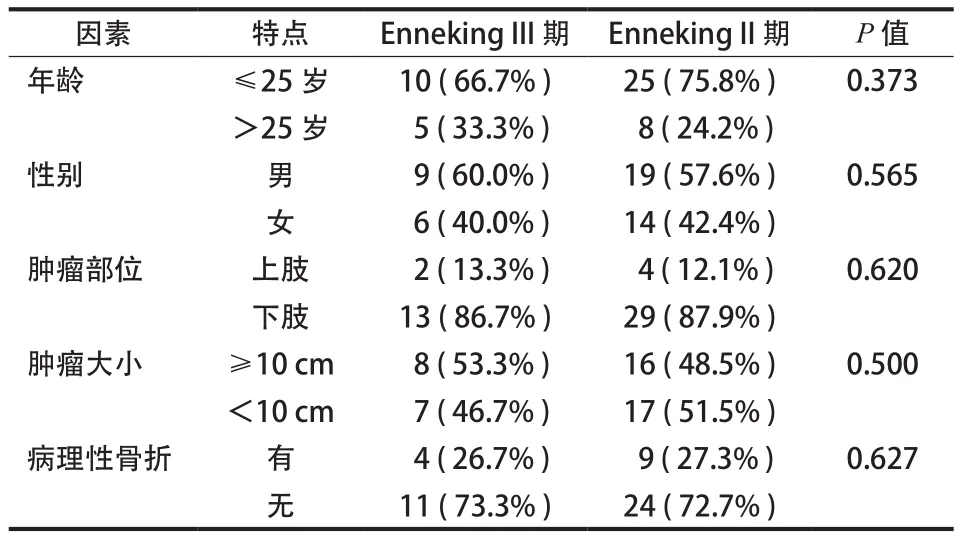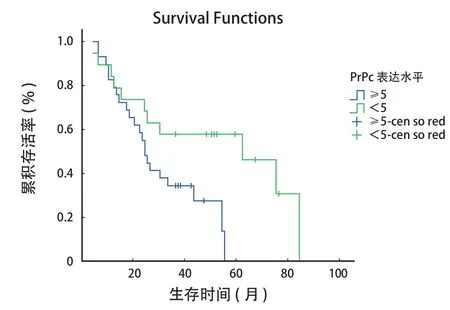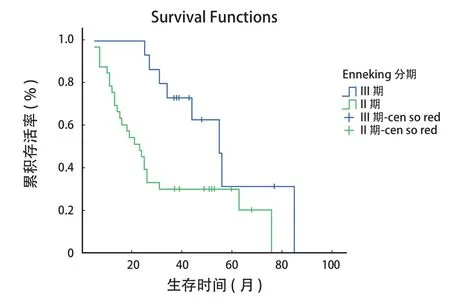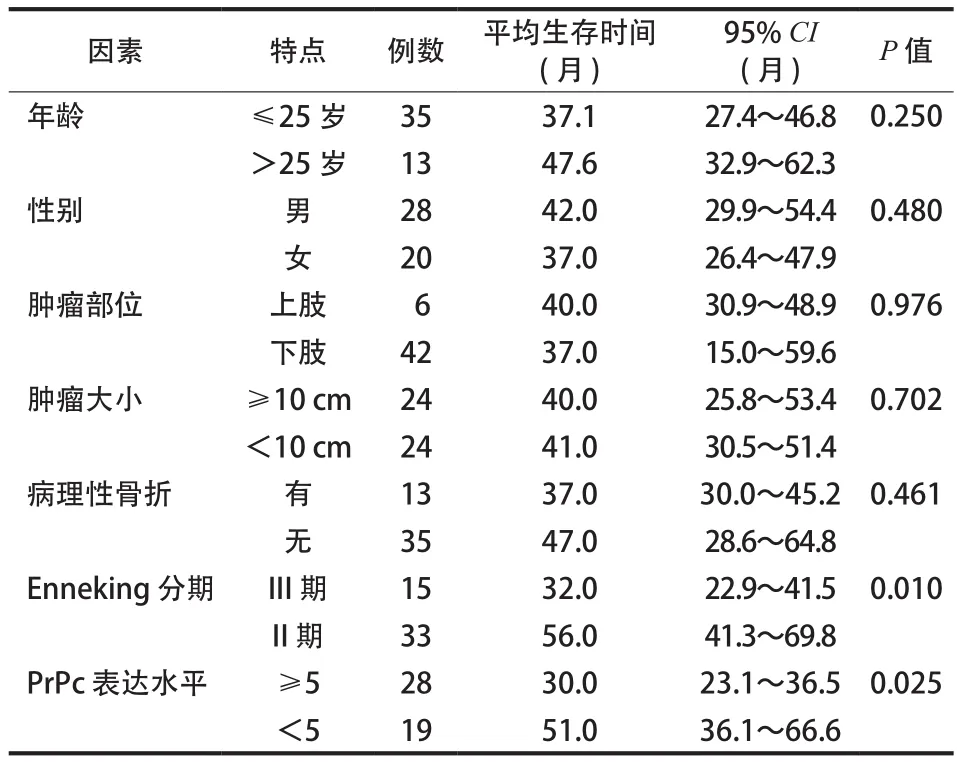朊蛋白 PrPc 在 Enneking III 期骨肉瘤中的表达及预后相关性分析
2014-02-13白云鹏张智长杨庆诚徐泽全阎洪亮
白云鹏 董 扬 张智长 杨庆诚 徐泽全 阎洪亮
. 骨肿瘤 Bone neoplasms .
朊蛋白 PrPc 在 Enneking III 期骨肉瘤中的表达及预后相关性分析
白云鹏 董 扬 张智长 杨庆诚 徐泽全 阎洪亮
目的探讨朊蛋白 PrPc ( cellular prion protein ) 在 Enneking III 期骨肉瘤中的表达以及分析其与骨肉瘤转移和患者预后的相关性。方法采用免疫组织化学法 ( SP 法 ) 对初诊已发生肺转移的 Enneking III期骨肉瘤15 例以及相应瘤旁组织中朊蛋白 PrPc 的表达进行检测。同时,检测同期收治的初诊未转移骨肉瘤标本 33 例作为对照组。比较已有转移的骨肉瘤和未转移骨肉瘤中 PrPc 蛋白的表达水平。对 2006 年1 月至2009 年12 月收住院的两组骨肉瘤患者的临床资料进行回顾性分析。收集年龄、性别、肿瘤部位、肿瘤大小、病理性骨折、生存时间等资料。应用 Kaplan-Meier 法计算患者生存年率,应用 Log-rank 检验进行单因素分析,应用 Cox 回归模型进行多因素分析,探讨 PrPc 的表达和不同的临床特征与骨肉瘤患者预后生存率之间的关系。结果PrPc 蛋白在骨肉瘤组织中普遍表达,在瘤旁组织中不表达;Enneking III 骨肉瘤中 PrPc 的表达要显著高于 Enneking II 期对照组 ( P=0.006 )。Kaplan-Meier 生存分析和 Log-rank 检验显示 PrPc 的表达水平与骨肉瘤患者预后相关 ( P=0.010 ),Enneking 分期与预后相关 ( P=0.025 )。多因素分析显示,PrPc 表达水平和肿瘤的 Enneking 分期可以作为骨肉瘤预后的独立影响因素。结论朊蛋白 PrPc 在已有转移的 Enneking III 骨肉瘤中的表达高于未转移患者。PrPc 高表达的骨肉瘤患者预后较差。PrPc 的高表达可能与骨肉瘤预后不良有一定相关性。
骨肉瘤;基因表达;预后;朊蛋白
骨肉瘤是源于间叶组织以能产生骨样组织的梭形基质细胞为特征的恶性肿瘤[1]。随着新辅助化疗的规范应用,手术理念和技术的日益进步,骨肉瘤总体预后有了较大的提高,5 年生存率从原来单纯以截肢手术时的20% 提高到 60%~70%[2],但那些就诊时已经发生肺转移的患者死亡率仍居高不下[3]。朊蛋白 PrPc 是由位于20 号染色体上相间隔的两个基因 PRNP,PRND 编码的一类相对分子质量为 33 000~35 000 U 的蛋白质,传统意义上认为它是引起传染性海绵状脑病 ( TSE ) 的病原体。近年来研究表明,PrPc 的过表达与人类多种癌症如肺癌、胃癌、结肠癌、胰腺癌和前列腺癌[4]的发生和转移有关,但在骨肉瘤中是否高表达,以及与骨肉瘤的肺转移是否存在相关性至今仍无报道。
资料与方法
一、一般资料
2006 年1 月至 2009 年12 月,我院收治的骨肉瘤患者 48 例,男28 例,女20 例,就诊时年龄7~55 岁。肱骨近端6 例,股骨远端22 例,胫骨近端17 例,腓骨近端3 例。术前测量肿瘤体积,最大径为6~16 cm。入院时已发生病理性骨折的13 例。Enneking III 期骨肉瘤15 例,Enneking II 期骨肉瘤33 例。病理类型均为普通型。术前均行1~2 疗程的新辅助化疗,化疗方案为 AP-HDMTX-IFO 贯序化疗。采用保肢手术 38 例,截肢术16 例。术后患者定期随访,分别于术后1 个月、3 个月、半年、1 年,之后每隔1 年随访1 次,记录术后功能、肿瘤复发及转移情况和生存时间。
二、蛋白检测
采用免疫组织化学 SP 三步法进行免疫组化检测。(1) 烤片:68 ℃,20 min;(2) 二甲苯脱蜡,梯度酒精脱水;(3)3% H2O237 ℃下孵育10 min,PBS 冲洗5 min×3 次以阻断灭活内源性过氧化物酶;(4) 抗原修复:将切片置入 0.01 M 枸橼酸缓冲液 ( pH6.0 ) 中,微波炉加热至沸腾后断电,自然冷却20 min,再放入冷水中冲洗,加快冷却至室温,然后用 PBS 冲洗5 min×3 次;(5) 正常羊血清工作液封闭,室温下放置10 min,倒去工作液勿冲洗;(6) 滴加1∶100 浓度稀释好的 PrPc 一抗,4 ℃ 冰箱孵育过夜,PBS 冲洗5 min×3 次;滴加生物素标记的二抗,37 ℃ 孵育 30 min,PBS 冲洗5 min×3 次;(7) 滴加辣根过氧化物酶标记的链霉素卵白素工作液,37 ℃ 孵育 30 min,PBS 冲洗5 min×3 次;(8 ) DBA 显色剂显色5~10 min,自来水充分冲洗后,苏木素复染,常规脱水,透明,干燥,封片。实验中用 PBS 代替一抗作为阴性对照。
三、结果判定及染色评分
采用已检出的 PrPc 阳性片作为阳性对照,用PBS 代替一抗作为阴性对照,以排除假阳性结果。PrPc 阳性染色呈棕黄色,主要定位于细胞膜和细胞浆内。采用半定量计数法对染色结果评分,40×10高倍镜下随机取5 个视野,每个视野计数 100 个细胞,根据染色强度结合和每个视野中阳性细胞百分比综合计分。染色强度:细胞无染色为 0 分;细胞膜、胞浆呈淡棕色为1 分;呈棕色者为2 分;深棕色为3 分。阳性细胞百分比 ≤10% 为 0 分;≤25%为1 分;≤50% 为2 分;≤75% 为3 分;>75% 为4 分。然后将染色强度和阳性细胞百分比得分的乘积作为免疫组化染色结果进行评分分级:0 为阴性(-),1~4 为弱阳性 ( + ),5~8 为中度阳性 ( ++ ),9~12 为强阳性 ( +++ )。
四、统计方法
结 果
朊蛋白 PrPc 在所有骨肉瘤标本中均表达,其阳性染色定位于细胞膜和胞浆内,呈棕黄色或深褐色颗粒 ( 图1)。着色深度和细胞阳性率在不同的标本间存在差异 ( 图2)。在瘤外组织内,PrPc 不表达( 图3)。在15 例 Enneking III 期骨肉瘤中,标本染色评分为7.20±2.484;相对于对照组 33 例 Enneking II 期骨肉瘤中,标本染色评分为4.73±2.842,P=0.006,两者差异有统计学意义。χ2检验率的比较显示实验组和对照组之间在年龄、性别、肿瘤部位、肿瘤体积、病理性骨折等方面差异无统计学意义( 表1)。用 Kaplan-Meier 法计算生存率并绘制生存曲线,Log-rank 单因素方差分析显示,骨肉瘤患者预后生存率与性别、肿瘤部位、肿瘤大小以及是否病理性骨折无关 ( 表2),与患者 PrPc 的表达水平( <5 分与≥5 分 ) ( 图4) 及 Enneking 分期 ( 图5) 相关。Cox 多因素分析显示,PrPc 表达水平和肿瘤的Enneking 分期可以作为骨肉瘤预后的独立影响因素( 表3)。

图1 免疫组化显示骨肉瘤组织中 PrPc 强阳性表达 (10×40 )图2 免疫组化显示骨肉瘤组织中 PrPc 弱阳性表达 (10×40 )图3 在瘤外组织内 PrPc 呈阴性 (10×40 )Fig.1 The immunohistochemistry showed strongly positive expressions of PrPc in osteosarcoma (10×40 )Fig.2 The immunohistochemistry showed weakly positive expressions of PrPc in osteosarcoma (10×40 )Fig.3 The negative PrPc expressions in adjacent tissues (10×40 )

表1 实验组和对照组在年龄、性别、肿瘤体积、病理性骨折等方面差异无统计学意义Tab.1 There were no statistically significant differences between the experimental group and the control group in the age, sex, tumor location, tumor size and pathologic fractures

图4 Kaplan-Meier 生存曲线显示, PrPc 高表达 ( ≥5 分 ) 骨肉瘤患者与低表达 ( <5 分 ) 生存率的差异Fig.4 The Kaplan-Meier survival curve showed the differences in the survival rate between high PrPc expressions in osteosarcoma ( ≥5 points ) and low PrPc expressions in osteosarcoma ( <5 points )

图5 Kaplan-Meier 生存曲线显示,Enneking III 期和 Enneking II期骨肉瘤生存率之间的差异Fig.5 The Kaplan-Meier survival curve showed the differences in the survival rate between the patients of Enneking III osteosarcoma and the patients of Enneking II osteosarcoma
讨 论
骨肉瘤是源于间叶组织以能产生骨样组织的梭形基质细胞为特征的恶性肿瘤,最常见于青少年。骨肉瘤的治疗在骨肿瘤领域一直是个难题,随着新辅助化疗的规范应用,手术理念和技术的日益进步,虽然总体预后有了较大的提高,但那些已经发生转移的患者预后仍差。因此、人们逐渐把目光移向更接近肿瘤本质的基因靶向治疗方面。根据肿瘤发生和转移的多基因、多步骤学说,骨肉瘤发生和转移的过程有多种基因参与其中,例如与细胞外基质侵袭性相关的 EGR1、Endothelin-1、CYR61 等,与免疫逃逸相关的 Fas、CD25 等,与靶器官捕获和黏附相关的 CXCR-4、Ezrin 等,以及与新生血管生成相关的 VEGF、STAT3 等。这些不同阶段基因的改变最终导致了骨肉瘤的发生和转移。

表2 不同临床特征与骨肉瘤预后生存率的关系Tab.2 The relationship between the different clinical features and the survival rate of the patients with osteosarcoma

表3 Cox 多因素模型回归分析Tab.3 The multivariate Cox regression analysis model
朊病毒蛋白 PrPc 由 Prusiner 等[5]于 1982 年发现,人朊蛋白基因位于20 号染色体上,由两段相互间隔的基因 PRNP,PRND 共同编码的由 253 个氨基酸组成的蛋白质[6]。通常意义上人们认为 PrPc是人或动物海绵状神经变性性脑病,如克雅病的病原体,然而近年来研究发现,PrPc 不仅在人类神经系统中表达,在其它组织细胞中也可表达,如在胎盘、睾丸、肺上皮细胞、血液系统淋巴细胞、单核细胞、血小板、肝星形细胞等[7]。越来越多的研究表明,PrPc 与人类多种肿瘤的发生和转移有关。其主要理论依据在于,人们发现 PrPc 可以通过一系列瀑布式级联反应以及不同的信号转导通路来促进肿瘤细胞的抗凋亡、过度增殖、侵袭和药物耐受性等特性[8]。
PrPc 可以通过不同的信号转导途径来导致癌症的发生并促进其转移,这一作用在一些人类实质性肿瘤中已得到初步证实。Meslin 等[9]用免疫组化方法检测 756 例原发性乳腺癌 PrPc 的表达,发现PrPc 在肿瘤细胞中的阳性率为15% ( 113 / 756 ),且 PrPc 的过表达与乳腺癌辅助化疗的耐药性有关。Liang 等[10]发现 PrPc 在胃癌组织标本中高表达,并且 PrPc 可以通过抑制 ROS 同时上调 Bcl-2 的表达来减缓癌细胞的凋亡。Du 等[11]通过 Northern blot和 PCR 发现 PrPc 在阿霉素、长春新碱、顺铂、5-FU、环磷酰胺和异环磷酰胺等多种化疗药物耐药的胃癌细胞株 SGC7091 / ADR 中过表达相关,通过免疫组化检测胃癌标本,其阳性率为 52.2% (12 /23 ),相对于癌旁组织 30.4% (7 /23 ) 有显著性差异。Antonacopoulou 等[12]应用 rt-PCR 检测 110 例结肠癌患者和 124 名正常人 PrPc 基因 PRNP 的表达,并用免疫组化法检测 PrPc 在 68 结肠癌组织中的表达。发现结肠癌患者无论从基因水平还是蛋白水平,PrPc 的表达均高于对照组,且 PrPc 的表达水平与结肠癌的复发相关 ( P=0.07 )。Diarra 等[13]在研究肿瘤细胞 TNF-α 耐药性的主导基因时发现,PrPc在 TNF 抵抗的乳腺癌细胞株中,mRNA 表达水平是TNF 敏感性细胞株的17 倍。在蛋白水平,PrPc 在TNF 抵抗的乳腺癌组织的表达同样高于对照。应用重组质粒转染发现,高表达的 PrPc 可以将 TNF 敏感性细胞向 TNF 抵抗性细胞转换。大量的基础和临床试验证实,PrPc 在人类肿瘤的发生和转移中起着重要作用。但究竟是朊蛋白的过表达直接导致癌症的发生还是高表达的朊蛋白仅仅赋予了一些肿瘤细胞亚群特有的生存优势从而被条件选择出来,仍然需要进一步探究。
迄今为止,有关 PrPc 与骨肉瘤的相互关系较少见诸报道[14],尚无明确结论。在本实验中,我们首先通过免疫组织化学方法检测 PrPc 在 48 例骨肉瘤组织以及相应癌旁组织中的表达情况,结果发现PrPc 在普通型骨肉瘤组织中普遍表达,而在癌旁正常组织中未见表达,说明 PrPc 的高表达与骨肉瘤细胞的存在有关。PrPc 是一种膜蛋白,由核糖体合成,通过内质网折叠和高尔基体修饰转运到达细胞膜,因此主要阳性染色位于细胞膜和胞浆内[15]。在比较不同转移情况的骨肉瘤中 PrPc 表达水平时我们发现,有转移的 Enneking III 期骨肉瘤和未转移的Enneking II 期骨肉瘤之间表达水平存在差异,前者显著高于后者,说明 PrPc 的高表达与骨肉瘤的转移可能存在一定的相关性。但具体作用机制和信号转导通路的发现尚需进一步深入研究。
关于 PrPc 的表达水平是否影响骨肉瘤预后,目前国内外尚无报道。我们通过 Kaplan-Meier 生存分析和 Log-rank 检验发现不同表达水平的骨肉瘤患者预后存在差异,PrPc 高表达 ( ≥5 分 ) 患者预后较低表达患者差 ( P<0.05 ),这说明 PrPc 的表达水平与骨肉瘤的预后存在一定的关系。我们推断,因为骨肉瘤一旦发生转移,就预示着预后不良,发生肺转移是导致骨肉瘤患者死亡的最主要原因,PrPc 的高表达与骨肉瘤转移相关,这可能是 PrPc 影响骨肉瘤预后的潜在原因。
关于骨肉瘤的预后影响因素,无论是从临床病理因素还是从分子生物学角度,国内外学者有不同的见解。Marcove 等[16]通过回顾性分析 145 例手术治疗的骨肉瘤患者的临床资料发现,仅年龄和肿瘤生长部位影响骨肉瘤肺转移的出现时间,其它临床因素并不影响5 年生存率。Bieling 等[17]认为骨肉瘤的预后与肿瘤体积有关,肿瘤体积较大的患者预后较差。Ozaki 等[18]认为骨肉瘤预后与生长部位有关,脊柱和胸肋骨的骨肉瘤预后较四肢骨肉瘤差。在生化方面,Wu 等[19]发现乳酸脱氢酶 ( LDH ) 较高的患者,更容易发生转移,因而预后较差。Ferrari等[20]发现碱性磷酸酶的水平对骨肉瘤的预后造成影响,碱性磷酸酶越高预后越差。还有学者认为人种差异和不同地区社会经济因素也会对骨肉瘤的生存预后造成一定影响[21]。当然,肿瘤的手术范围,是否新辅助化疗,以及肿瘤坏死率等预后影响因素已经得到人们的广泛认可。本研究通过比较本组48 例不同临床特征与预后的关系,发现性别、年龄、肿瘤生长部位、肿瘤大小、病理性骨折等因素与预后生存率无关,而不同的 PrPc 的表达水平以及Enneking 分期与预后存在相关关系。这表明 PrPc 的表达水平可能作为骨肉瘤预后的独立影响因素。但鉴于本试验样本量较少,随访时间不够长 ( 最长随访7 年 ),尚需要更大样本的多中心试验来进一步验证。
[1]Picci P. Osteosarcoma (osteogenic sarcoma). Orphanet J Rare Dis, 2007,2(1):6.
[2]Gosheger G, Gebert C, Ahrens H, et al. Endoprosthetic reconstruction in 250 patients with sarcoma. Clin Orthop Relat Res, 2006, 450(12):164-171.
[3]Kager L, Zoubek A, Potschger U, et al. Primary metastatic osteosarcoma: presentation and outcome of patients treated on neoadjuvant. Cooperative Osteosarcoma Study Group protocols. J Clin Oncol, 2003,21(10):2011-2018.
[4]Mehrpour M, Codogno P. Prion protein: From physiology to cancer biology. Cancer Letters, 2010, 290(1):1-23.
[5]Prusiner SB. Novel proteinaceous infectious particles cause scrapie. Science, 1982, 216(4542):136-144.
[6]Prusiner SB. Molecular biology and pathogenesis of prion diseases. Trends Biochem Sci, 1996,21(12):482-487.
[7]Kitada T, Seki S, Ikeda K, et al. Clinicopathological characterization of prion: a novel marker of activated human hepatic stellate cells. Hepatol J, 2000, 33(5):838-841.
[8]Antonacopoulou AG, Palli M, Marousi S, et al. Prion protein expression and the M129V polymorphism of the PRNP gene in patients with colorectal cancer. Mol Carcinog, 2010, 49(7): 693-699.
[9]Meslin F, Conforti R, Mazouni C, et al. Efficacy of adjuvant chemotherapy according to Prion protein expression in patients with estrogen receptor-negative breast cancer. Ann Oncol, 2007,18(11):1793-1798.
[10]Liang J, Pan YL, Ning XX, et al. Overexpression of PrPc and its antiapoptosis function in gastric cancer. Tumour Biol, 2006,27(2):84-91.
[11]Du J, Pan Y, Shi Y, et al. Overexpression and significance of prion protein in gastric cancer and multidrug-resistant gastric carcinoma cell line SGC7901/ADR. Int J Cancer, 2005, 113(2):213-220.
[12]Antonacopoulou AG, Grivas PD, Skarlas L, et al. POLR2F, ATP6V0A1 and PRNP expression in colorectal cancer: new molecules with prognostic significance? Anticancer Res, 2008,28(2B):1221-1227.
[13]Diarra-Mehrpour M, Arrabal S, Jalil A, et al. Prion protein prevents human breast carcinoma cell line from tumor necrosis factor alpha-induced cell death. Cancer Res, 2004, 64(2): 719-727.
[14]Sollazzo V, Galasso M, Volinia S, et al. Prion proteins (PRNP and PRND) are over-expressed in osteosarcom. J Orthop Ses, 2012, 30(6):1004-1012.
[15]Vey M, Pilkuhn S, Wille H, et al. Subcellar colocalization of the cellular and scrapie prion proteins in caveolae-like membranous domains. Pro Natl Acad Sci USA, 1986, 93(25):14945-14949.
[16]Marcove RC, Mike V, Hajek JV, et al. Osteogenic sarcoma under the age of twenty-one. A review of one hundred and forty-five operative cases. J Bone Joint Surg Am, 1970, 52(3):411-423.
[17]Bieling P, Rehan N, Winkler P, et al. Tumor size and prognosis in aggressively treated osteosarcoma. J Clin Oncol, 1996,14(3):848-858.
[18]Ozaki T, Flege S, Liljengvist U, et al. Osteosarcoma of the spine:experience of the Cooperative osteosarcoma Study Group. Cancer, 2002, 94(4):1069-1077.
[19]Wu PK, Chen WM, Chen CF, et al. Primary osteogenic sarcoma with pulmonary metastasis: clinical results and prognostic factors in patients. Jpn J Clin Oncol, 2009, 39(8):514-522.
[20]Ferrari S, Bertoni F, Mercuri M, et al. Predictive factors of disease-free survival for non-metastatic osteosarcoma of the extremity: an analysis of 300 patients treated at the Rizzoli Institute. Ann Oncol, 2001,12(8):1145-1150.
[21]Nathan SS, Healey JH. Making a case for the socioeconomic determinacy of survival in osteosarcoma. Clin Orthop Relat Res, 2013, 471(3):784-791.
( 本文编辑:王永刚 )
Expressions of cellular prion protein and the correlation analysis of prognosis in osteosarcoma of Enneking III
BAI Yun-peng, DONG Yang, ZHANG Zhi-chang, YANG Qing-cheng, XU Ze-quan, YAN Hong-liang. Department of Orthopedics, the sixth People’s Hospital Affliated to Shanghai Jiaotong University, 200233, PRC
ObjectiveTo investigate the expressions of cellular prion protein ( PrPc ) in Enneking III osteosarcoma and analyze its correlation with the metastasis and prognosis.MethodsImmunohistochemistry streptavidin-perosidase ( SP ) method was used to detect the expressions of PrPc in15 patients with osteosarcoma of Enneking III who had pulmonary metastases at the frst visit and in the corresponding adjacent tissues. By contrast, the same detection was performed on 33 patients with non-metastatic osteosarcoma at the first visit who were adopted during the same period. The expressions of PrPc between the2 groups were compared. The clinical data of the 48 patients with osteosarcoma were retrospectively reviewed, including the sex, age, tumor location, tumor size, pathologic fractures, survival time and so on. Their admission time ranged from January 2006 to December 2009. The Kaplan-Meier method was used to measure the overall survival rate. A log-rank univariate analysis was used to determine the prognostic factors related to the survival rate. The Cox multivariate analysis model was used to identify the independent prognostic factors. The relationship between the expressions of PrPc and different clinical features and the survival rate in the patients with osteosarcoma were explored.ResultsThe expressions of PrPc were noticed in the osteosarcoma tissues but not in the adjacent tissues. The expression level in the patients with Enneking III osteosarcoma was signifcantly higher than that in the control group ( P=0.006 ). The Kaplan-Meier survival analysis and Log-rank test showed that the PrPc expression level ( P=0.010 ) and the Enneking staging ( P=0.025 ) were related to the prognosis. The Cox regression analysis showed that the PrPc expression level and the Enneking staging were the prognostic factors of osteosarcoma patients.ConclusionsThe PrPc expressions are signifcantly higher in the patients with metastatic osteosarcoma of Enneking III than in the non-metastatic group. The higher PrPc expressions indicate apoor prognosis. The PrPc expressions may be associated with the poor prognosis of osteosarcoma.
Osteosarcoma; Gene expression; Prognosis; PrPc
10.3969/j.issn.2095-252X.2014.07.008
R738.1
200233 上海交通大学附属第六人民医院骨科
董扬,Email: dongyang6405@163.com
2013-06-24 )
